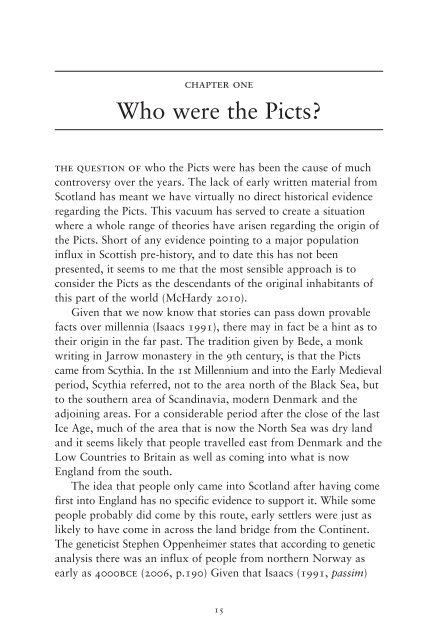Pagan Symbols of the Picts by Stuart McHardy sampler
Stuart McHardy examines the Pictish symbols which have been discovered on various items across Scotland. The book sets out a cohesive interpretation of the Pictish past, using a variety of both temporal and geographical sources. This interpretation serves as a backdrop for his analysis of the symbols themselves, providing a context for his suggestion that there was an underlying series of ideas and beliefs behind the creation of the symbols.
Stuart McHardy examines the Pictish symbols which have been discovered on various items across Scotland. The book sets out a cohesive interpretation of the Pictish past, using a variety of both temporal and geographical sources. This interpretation serves as a backdrop for his analysis of the symbols themselves, providing a context for his suggestion that there was an underlying series of ideas and beliefs behind the creation of the symbols.
You also want an ePaper? Increase the reach of your titles
YUMPU automatically turns print PDFs into web optimized ePapers that Google loves.
chapter one<br />
Who were <strong>the</strong> <strong>Picts</strong>?<br />
<strong>the</strong> question <strong>of</strong> who <strong>the</strong> <strong>Picts</strong> were has been <strong>the</strong> cause <strong>of</strong> much<br />
controversy over <strong>the</strong> years. The lack <strong>of</strong> early written material from<br />
Scotland has meant we have virtually no direct historical evidence<br />
regarding <strong>the</strong> <strong>Picts</strong>. This vacuum has served to create a situation<br />
where a whole range <strong>of</strong> <strong>the</strong>ories have arisen regarding <strong>the</strong> origin <strong>of</strong><br />
<strong>the</strong> <strong>Picts</strong>. Short <strong>of</strong> any evidence pointing to a major population<br />
influx in Scottish pre-history, and to date this has not been<br />
presented, it seems to me that <strong>the</strong> most sensible approach is to<br />
consider <strong>the</strong> <strong>Picts</strong> as <strong>the</strong> descendants <strong>of</strong> <strong>the</strong> original inhabitants <strong>of</strong><br />
this part <strong>of</strong> <strong>the</strong> world (<strong>McHardy</strong> 2010).<br />
Given that we now know that stories can pass down provable<br />
facts over millennia (Isaacs 1991), <strong>the</strong>re may in fact be a hint as to<br />
<strong>the</strong>ir origin in <strong>the</strong> far past. The tradition given <strong>by</strong> Bede, a monk<br />
writing in Jarrow monastery in <strong>the</strong> 9th century, is that <strong>the</strong> <strong>Picts</strong><br />
came from Scythia. In <strong>the</strong> 1st Millennium and into <strong>the</strong> Early Medieval<br />
period, Scythia referred, not to <strong>the</strong> area north <strong>of</strong> <strong>the</strong> Black Sea, but<br />
to <strong>the</strong> sou<strong>the</strong>rn area <strong>of</strong> Scandinavia, modern Denmark and <strong>the</strong><br />
adjoining areas. For a considerable period after <strong>the</strong> close <strong>of</strong> <strong>the</strong> last<br />
Ice Age, much <strong>of</strong> <strong>the</strong> area that is now <strong>the</strong> North Sea was dry land<br />
and it seems likely that people travelled east from Denmark and <strong>the</strong><br />
Low Countries to Britain as well as coming into what is now<br />
England from <strong>the</strong> south.<br />
The idea that people only came into Scotland after having come<br />
first into England has no specific evidence to support it. While some<br />
people probably did come <strong>by</strong> this route, early settlers were just as<br />
likely to have come in across <strong>the</strong> land bridge from <strong>the</strong> Continent.<br />
The geneticist Stephen Oppenheimer states that according to genetic<br />
analysis <strong>the</strong>re was an influx <strong>of</strong> people from nor<strong>the</strong>rn Norway as<br />
early as 4000bce (2006, p.190) Given that Isaacs (1991, passim)<br />
15


















